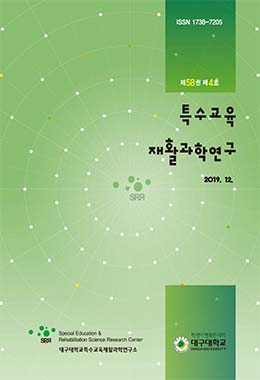브로카 실어증 환자들은 명사를 산출하는 것 보다 사람이나 사물의 움직임을 나타내는 동사를 표현하는 것에 더 어려움을 가진다. 본 연구에서는 다감각적 정보를 제공하는 증강현실기반 언어중재가 브로카 실어증 환자의 동사 어휘 습득에 어떠한 영향을 미치는지 알아보기 위해 성인 실어증 환자들을 대상으로 언어치료를 실시하고 그 효과를 알아보고자 하였다.
브로카 실어증 환자들의 동사 습득 수준을 파악하기 위해 매 회기 동사 이름대기 점수를 분석하여 정반응률을 파악하였고, 자발화 수준에서 어휘다양도가 향상 되는지 분석하였다. 또한, 표준화된 검사 도구인 파라다이스 한국판 웨스턴 실어증 검사 개정판(PK-WAB-R)과 보스턴 이름대기 검사(K-BNT)를 실시하여 대상자들의 향상된 동사 이름대기 능력이 다른 언어영역에도 일반화 될 수 있는지를 파악하고자 하였다.
연구대상은 브로카 실어증 환자 3명을 대상으로 단일대상 연구 방법 중 중다기초선 설계로 실험을 실시하였다. 중재 효과를 심도 있게 평가하기 위해 3명의 소수 대상자를 선정하였다. 파라다이스 한국판 웨스턴 실어증 검사 개정판(PK-WAB-R)을 실시하여 심도와 중등도 실어증으로 진단받은 환자를 선정하였고, 뇌졸중 발병 후 자발적인 회복 기간이 지났다고 판단되는 발병 후 6개월이 지난 만성기 환자들을 대상으로 하였다.
증강현실 애플리케이션으로 구현되는 동사 68개 어휘 중에서 대상자들에게 고빈도로 사용된다고 판단한 어휘 26개를 선정하여 검사어휘로 선정하였다. 언어치료 중재는 총 24회기로 구성되어 있으며, 기초선 단계 3회기, 증강현실 언어치료 중재단계 20회기, 유지단계 1회기로 구성되었고 중재는 일대일로 진행되었다. 본 연구를 통해 증강현실 기반 언어중재가 나타낸 결과는 동사 이름대기 점수의 향상, 자발화 상황에서 어휘다양도와 품사별 어휘 산출빈도의 향상, 중재 전과 후의 언어지수와 실어증 지수의 향상을 보였다.
본 연구에서는 브로카 실어증 성인 환자를 대상으로 증강현실 기반 언어치료 프로그램을 적용해 보았고, 증강현실 기반 언어중재가 브로카 실어증 환자의 동사 어휘 개념 획득과 운동피질 영역에 영향을 미쳐 언어능력을 향상시키는 데에 도움이 되었다. 따라서 본 연구는 성인실어증 환자의 언어능력을 향상시킬 수 있는 의미 있는 데이터를 제공할 것으로 기대한다.
Patients with Broca’s aphasia feel more difficult in expressing the verbs indicating the movements of people and things rather than naming the nouns. The purpose of this study was to investigate the effects of an augmented reality-based language intervention program providing multi-sensory information on the acquisition of the verbs by adult patients with Broca’s aphasia.
In order to measure verb naming abilities of the patients, the scores of naming the verbs at every session were analyzed to know their percentage of correct answers. Further, improvement of Type-Token Ratio (TTR) at their spontaneous speech were analyzed. Also, standardized testing tools, Paradise Korea-Western Aphasia Battery (PK-WAB-R) and Boston Naming Test (K-BNT), are used to improve the verb naming abilities to judge whether it could be generalized in the other language areas.
To this end, three patients with Broca’s aphasia were sampled to be subject to the multiple baseline design that is one of the single subject researches. In order to evaluate the intervention effects in depth, only three subjects were sampled. The Paradise Korea-Western Aphasia Battery was used to identify the severe or moderate level aphasia, while the chronic stroke patients were sampled if their recovery time had elapsed after 6 months.
26 verbs out of 68 ones selected through the augmented reality application were chosen finally as test verbs because they were judged to be frequently used. The language intervention program consisted of 24 sessions in total: 3 sessions for the baseline, 20 ones for intervention stage and 1 session for the maintenance stage. The intervention was implemented one-to-one. The augmented reality-based language intervention program helped the subjects to enhance their verb-naming scores, improve their vocabulary diversity and vocabulary frequency per part at the spontaneous level as well as their language quotients and aphasia ones than before the therapy.
This study applied the augmented reality-based language intervention program to the patients with Broca’s aphasia and thereby, confirmed that the intervention program helped the subjects much to acquire the concepts of the verb and improve their language competence by affecting their motor cortex. Lastly, it is hoped that this study would provide meaningful data to the improvement of adults aphasia patients’ language competence.


